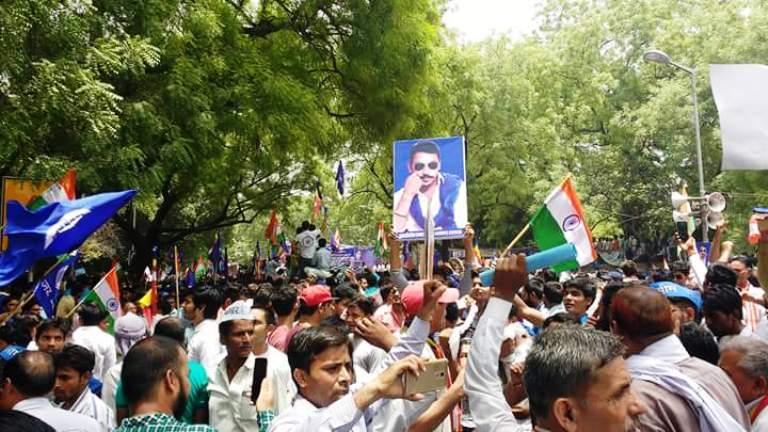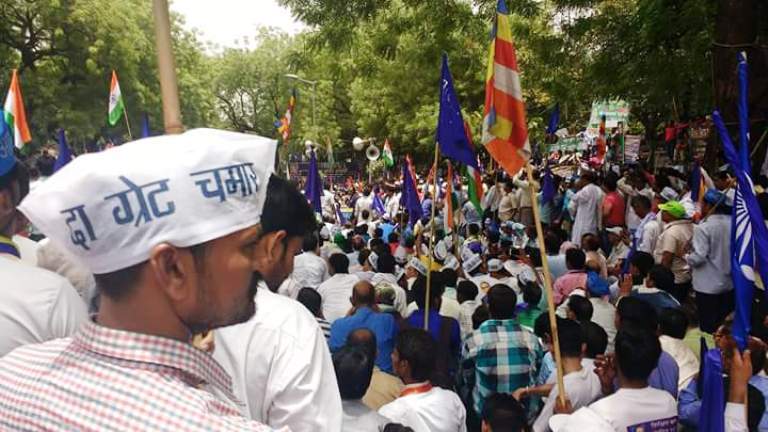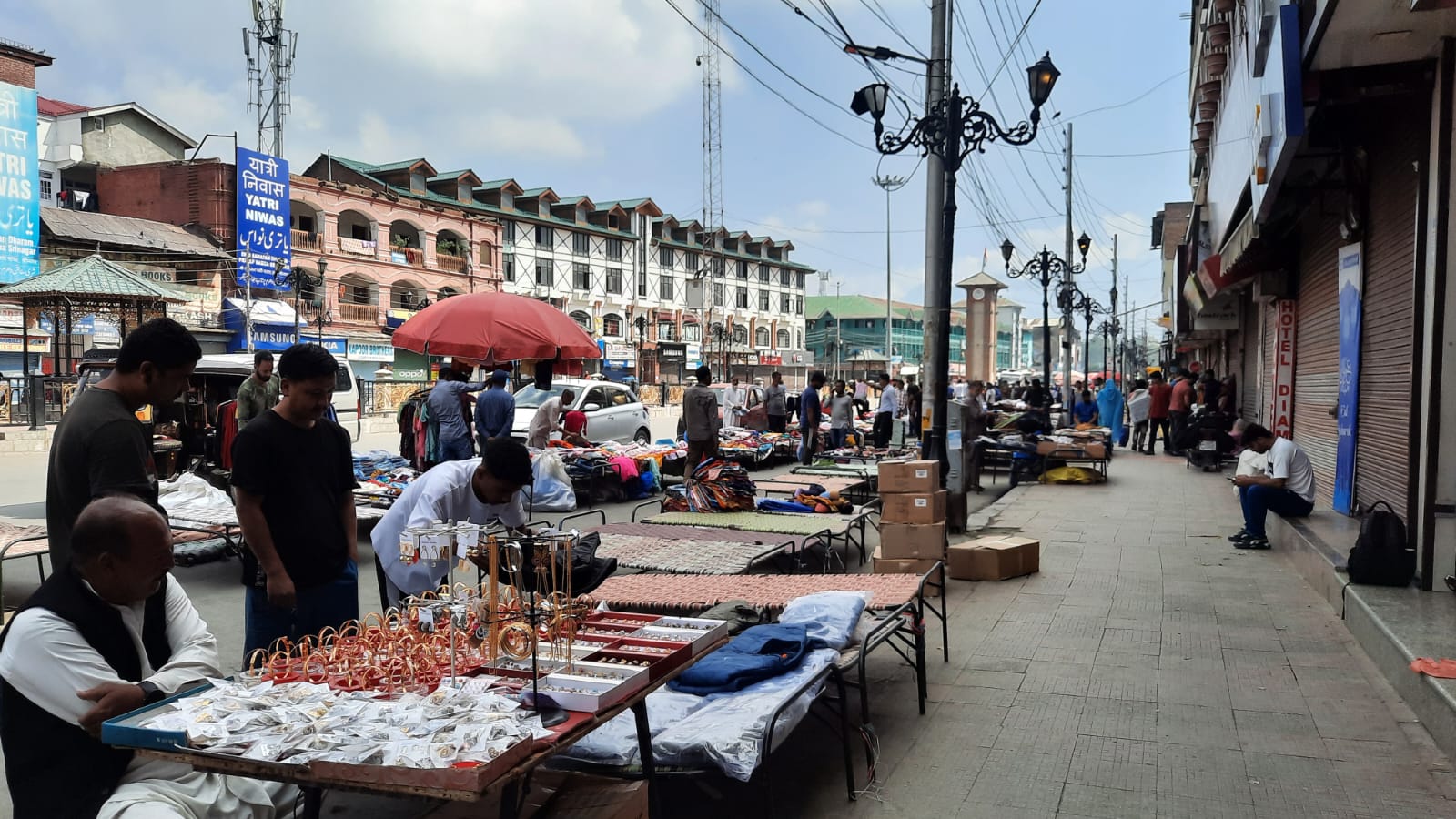“This is a platform of all Dalit organizations. I will not accept this blue ‘pagdi’ [turban] till saffron terror is eliminated from this country.” This was what Chandrashekhar Azad, alias Ravana, said at Jantar-Mantar in New Delhi before a crowd of thousands on 21 May. He is the same person who has given a new idiom to Dalit resistance by founding Bhim Army. What were the expectations of the people who had thronged Jantar-Mantar and how does Bhim Army relate to them? What are the dreams and objectives of Chandrashekhar, the founder, and Vinay Ratan Singh, the president of Bhim Army? How does Bhim Army propose to redeem those dreams? Before dwelling on these questions, it would be better to give the background – to throw some light on the events that led to Bhim Army and Chandrashekhar becoming a talking point nationally.
Bhim Army takes to the streets
On 5 May, after the Rajputs attacked Dalits in Shabirpur, a village about 29km from Saharanpur in western Uttar Pradesh, a large number of Dalit youths took to the streets to protest against the discriminatory attitude of the government and the administration. A clash between the angry youth and the large numbers of policemen ensued. The Dalit youths set a police post ablaze. Before that, some buses were set afire and roads were blocked. Bhim Army, a little-known organization in other parts of the country, organized the protest. Suddenly, the outfit and its founder Chandrashekhar Azad became the talk of the town. The administration was taken aback by the angry demonstration of thousands of youths, and the police registered a string of cases against Chandrashekhar.
Thus began the speculations. The local media and the police began talking about Chandrashekhar’s Naxal connections. There was also the rumour of how large amounts had been transferred to the bank accounts of the organization and its founder by unidentified sources. The stoning-pelting at the police in Saharanpur was likened to the stone-pelting incidents in Kashmir and posts speculating that international terror outfit ISIS was funding Bhim Army started becoming viral on social media. The local print media even carried stories suggesting that Bhim Army had drawn up an elaborate plan to vandalize and burn down the entire Saharanpur town.
More following, more hopes
The administration and most of the local media people are projecting Bhim Army and Chandrashekhar as a potent challenge to maintenance of law and order. Some say that Chandrashekhar and the Bhim Army are traitors or, at least, are backed by traitors. On the other hand, Dalitbahujans see a ray of hope in Bhim Army and see Chandrashekhar as their hero, as someone who would bring justice to them, would establish social equity and fulfil the dreams of Dr Ambedkar. One of the reasons for the hope is that the organization’s name suggests that it is Dr Ambedkar’s army. The huge crowd that assembled at Jantar-Mantar on 21 May was a reflection of this hope. Barring Bhim Army and its leadership, no one could have imagined that on the call of an unknown organization – that too only on social media – thousands would gather at Jantar-Mantar, taking grave risks.
The crowd that gathered at Jantar-Mantar was neither committed to any political party or ideology nor did it have any selfish agenda or specific political or ideological leanings. The people who had gathered at Jantar-Mantar were only actuated by anger and resentment against the barbarism of Rajputs at Shabirpur, the partisan attitude of the local administration, and the aggressive and inimical stance of the police against Bhim Army. The huge turnout at Jantar-Mantar was an expression of solidarity with Bhim Army and Chandrashekhar and of sympathy with the Shabbirpur Dalit victims. Though the Bhim Army had issued the call for the demonstration, the converging of the people was spontaneous. However, Bhim Army should be credited for managing the event successfully and in a disciplined manner.
Failure of established Dalit leadership
The banners and posters, the slogans on placards, the caps, the T-shirts, the demeanour of people, the speeches of Chandrashekhar and Vinay Singh – all were a pointer to the fact that in North India, particularly in Uttar Pradesh (especially in its western parts), the Dalit mindset had undergone a sea change. In Uttar Pradesh, Mayawati and her BSP has been the only political option for Dalits, because other major political players are either openly or tacitly anti-Dalit. That is because of their ideology, their beliefs and the sociopolitical matrix of the region. But it is equally true that the BSP and its leadership have failed to fulfil the social, cultural and economic aspirations of the Dalits. To satiate its lust for power, the BSP has given a go-by to these issues. It was the BSP that aroused Dalit aspirations but its conduct has left a vast section of the community disillusioned.
Mayawati’s silence boosted Chandrashekhar
Though the Dalits are not openly expressing their disillusionment, it was evident at Jantar-Mantar, where there wasn’t a single poster, banner or placard on Mayawati or the BSP and no slogan hailing Behenji was heard. No one spoke a word about her from the dais. Though there was no public display of anger against her, in private conversations people were expressing their resentment, especially because after the incident (21 May) she had not cared to even visit Saharanpur or express her solidarity with the Dalit victims. Chandrashekhar repeatedly asserted that he had not come to Jantar-Mantar to do politics and that he had nothing to do with politics or politicians. He was perhaps hinting at two things: One, that only politics of power would not fetch socio-cultural justice for Dalits and two, that he does not intend to politically weaken the BSP or emerge as its alternative.
Even while conceding that the BSP was their only political alternative, the Dalits of Uttar Pradesh have, for a while, wanted to launch a separate struggle on social and cultural fronts. This process had begun long ago and the BSP’s crushing defeats in 2014 and 2017 only served to hasten it. Those who gathered at Jantar-Mantar were hopeful that Bhim Army would be able to fulfil their social and cultural aspirations.
Dalits terror-stricken by BJP’s victory spree
BJP’s victories in national and Uttar Pradesh elections have created a sense of disquiet and terror among the Dalits. They fear that the country is on the way to becoming a Hindu Rashtra (Hindu nation). They consider BJP’s victory as the victory of the RSS. Most of the awakened Dalits believe that a Hindu Rashtra means resurgence of Brahmanism and domination of non-Dalits over Dalits. This was evident from the slogans and posters at Jantar-Mantar and from the speech of Chandrashekhar. The placards, among other things, said “End Manuvad”, “Down with Brahmanism”, “Down with Hinduism” and “End Saffron Terror”. The slogans were also centred on these issues. Some of the participants were even discarding Hindu symbols such as red threads tied on wrists, rosaries, amulets, etc, and trampling them underfoot.
When some people tried to make Chandrashekhar wear a blue pagdi, he refused, saying that this was a platform of all Dalit organizations and that he won’t wear it until saffron terror was eliminated from the country. All the political slogans being raised at the event were centred on Modi-Yogi and were brimming with anger against and hatred towards the prime minister and the Uttar Pradesh chief minister.
Chandrashekhar electrifies people
The enthusiasm of the crowd reached its peak when Chandrashekhar said he would not rest till Brahmanism was annihilated and Ambedkarism was established in the country. He said, “Some people say that I have some connection with the Sangh. I say that I hate the Sangh. It is the protector of Brahmanism. I am an Ambedkarite. There is no common ground between us.”
It seemed as if the people knew only two people – Ambedkar and Chandrashekhar. The place was resonating with the slogans, “Jai Bhim” and “Chandrashekhar zindabad”. What was apparent was that only social equality could satisfy the urge for equality and fraternity, which Dr Ambedkar had aroused among the Dalits. What seemed to have endeared Chandrashekhar to the Dalits is their hope that he would bring them justice and equality.
‘The Great Chamar’
The Jantar-Mantar protestors belonged to the age group 15-35 years. They belonged to the third generation of educated Dalits that is no respecter of caste-based graded hierarchy. They had no feeling of inferiority. The caps they were wearing and the placards they were carrying proudly declared them as “The Great Chamar”. Chandrashekhar said, “It is often asked, ‘If we do not believe in caste system, why do we describe ourselves as Great Chamar, why do we feel proud of our caste?’ Ambedkar had taught us that till the caste system is completely eliminated, we should feel proud of our caste and embarrass those who believe that their caste is superior. Moreover, when the government and the administration consider us Chamars, what is wrong in describing ourselves as such? Our caste certificates describe us as SC they also mention our sub-caste, ‘Chamar’.”
Respecting women
Besides Dalitbahujans, Chandrashekhar also spoke about women in his speech: “Some persons are spreading the rumour that Bhim Army wants to avenge the humiliation of Dalit women by the Savarnas, by molesting Savarna women. This is a white lie and a conspiracy to defame Bhim Army. Bhim Army considers protecting the respect and dignity of every woman – no matter which religion, caste or region she belongs to – its bounden duty. In this respect, Ambedkar and the fictional character of Ravana are our ideals. Babasaheb fought all his life for equal rights for women and with that objective, he introduced Hindu Code Bill in Parliament. When he could not get the legislation passed, he resigned as law minister. I have added ‘Ravana’ to my name to honour Ravana’s respect for women. While Ram had mutilated a woman [Shoorpnakha] and humiliated her, Ravana gave full respect to Sita despite the fact that he had abducted her as an act of revenge and being the king, he could have behaved with her in any manner he liked.”
Bhim Army is just two years old
According to Bhim Army’s president Vinay Ratan Singh, the first meeting of the organization was held on 21 July 2015 and the number of attendees was not more than 15. It was established with two main objectives: educating the Bahujans and protecting them from exploitation and atrocities. To achieve the first objective, Bhim Army started Bhim Schools. These schools are run with people’s co-operation. Students and those preparing for competitive examinations teach in these schools. The Bhim Schools also prepare students for appearing in competitive examinations and introduce them to the teachings and ideology of Ambedkar. Chandrashekhar also says that education is a weapon for struggle. So far, around 300 Bhim Schools have been established in and around Saharanpur.
It all started in his village
Chandrashekhar’s struggle began in his village. The management of AHP Inter College in his village Chutmalpur was in the hands of Rajputs. In the college, the Bahujan students were supposed to clean the benches on which the students sat. Dalits students who scored high marks were harassed in different ways. There was also an unwritten rule that Rajput boys were to be given priority in drinking water from the tap on the premises of the college. In 2015, a Kashyap (OBC) boy happened to drink water before Rajputs and was thrashed for it. Bhim Army intervened in the matter. Many panchayats were held and the issue was brought to the notice of the government and the administration. Ultimately, a compromise was reached and it was decided that all students would be treated equally. This helped Bhim Army earn a name for itself. According to Chandrashekhar and his associates, there are now around 10,000 members of Bhim Army in and around Saharanpur.
Chandrashekhar hails from Uttarakhand
Today, Chandrashekhar lives in a village called Chutmalpur, in Saharanpur, but his native village is Dada Patti, about 10km away, which falls in Uttarakhand. His father Govardhandas, who was a primary schoolteacher, had settled in Chutmalpur. Govardhandas father died of cancer in 2013. All the three sisters of Chandrashekhar are married. His younger and elder brothers farm the family’s 12-13 bigha land. Income from farming and the pension his mother has been getting after the death of his father are the sources of income of the family. When asked about farming, he says that in this country no one cares about the farmers. He says that Bhim Army is not an organization but an ideology. He believes in Babasaheb’s formulation that whenever there is a conflict between personal and national interests, one should sacrifice personal interest; but if there is a conflict between national interest and community’s interest, the community should come first.
As of now, Bhim Army is definitely giving expression to Dalit aspirations for justice and equality. His team, announced at Jantar-Mantar, includes, Dalits and OBCs too. Other communities, especially the minorities of western Uttar Pradesh, are also pinning their hopes on him because the perpetrators of atrocities on the minorities and the Dalits are the same. Muslims were also present in sizeable numbers at Jantar-Mantar. Jignesh Mewani’s presence underlined the solidarity of Dalit groups fighting for their rights in different parts of the country. Mewani targeted capitalism and Brahmanism in his speech. Supporters of the leftist outfit New Democracy were also present with their posters and slogans.
What form the Bhim Army will assume in the future and how effective a role it will play in fulfilling the aspirations of the Dalits, only time will tell.
Based in New Delhi, India, ForwardPress.in and Forward Press Books shed light on the widespread problems as well as the finer aspects of Bahujan (Dalit, OBC, Adivasi, Nomadic, Pasmanda) society, literature, culture and politics. Next on the publication schedule is a book on Dr Ambedkar’s multifaceted personality. To book a copy in advance, contact The Marginalised Prakashan, IGNOU Road, Delhi. Mobile: +919968527911.
For more information on Forward Press Books, write to us: info@forwardmagazine.in








